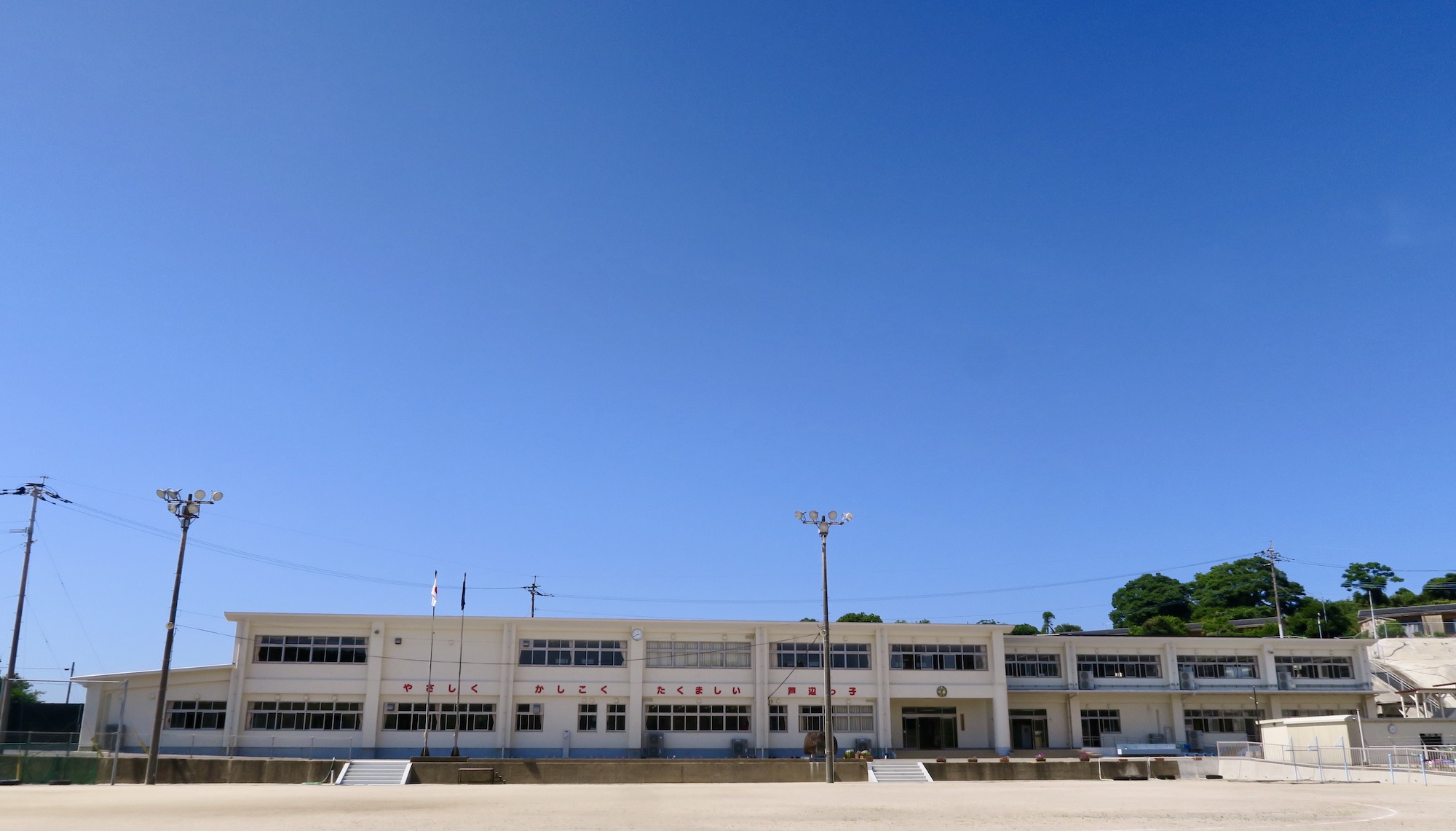My feet are soooo sunburnt. It looks like I am wearing crabs for slippers.
It has been one month of Japanese elementary school. My kids have done surprisingly well considering that Japanese is not really their mother tongue. There have been a couple of rough days, but overall they are maintaining a very high level of curiosity and drive.
This is my first time experiencing Japanese elementary school too. Not only am I experiencing through my kids, I am participating more in the school community. Certainly not having a regular job gives me the freedom to volunteer at the school, but Japanese elementary schools drag the parents into all sorts of activities. That is how I got terribly sunburned (more on that later).
Below I thought I would outline our experiences so far, what the kids do each day, what they learn, and then round up with a special event where I helped out at the school. This post is admittedly long — sorry about that! Hopefully I can keep you entertained. Keep in mind of course that whatever I say here can only be representative of our experience: even though the Japanese education system is centralized, there are many small localized variations.
Getting ready
At 6am each morning I climb the stairs to wake the kids up. They change, fold up their futon (sometimes), and come downstairs for breakfast. Preparation for school actually happens the night before, as they put together all the gear and completed homework they are supposed to bring for the next day. They eat a big breakfast. Unlike in Canada, there is no mid-morning snack break. They won’t get to eat until 12:30. Since the pandemic, every morning before leaving the students are required to take their temperature and record it on a sheet that is handed to the teacher. Once that is all done, they put on their nametag, hat, and load up their randoseru (ランドセル), those distinctive Dutch rucksacks that Japanese students have been using since the late 19th century.
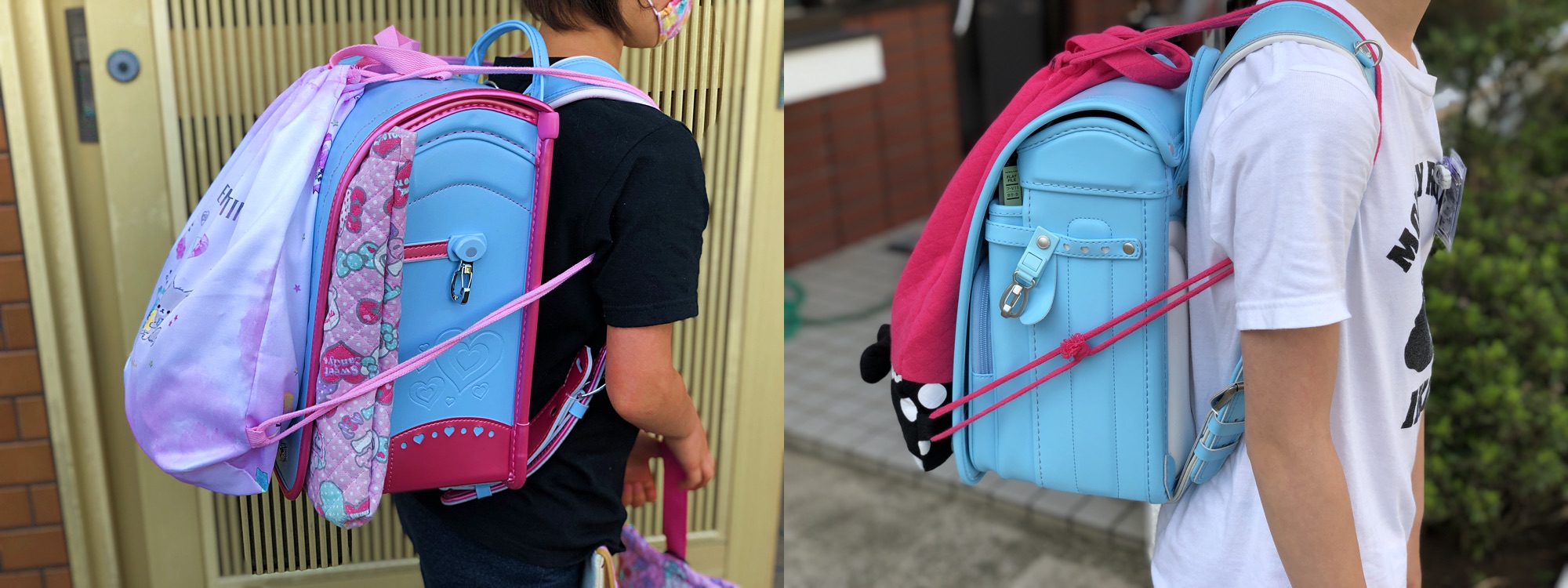
These backpacks are handmade works of art and can be quite expensive. They are super tough since they have to last a student from grade 1 to 6. I could go on about these bags, but that is out of scope of this post, so if you are curious read more about randoseru on Wikipedia →
Kids have to take a lot of stuff to school each day. Below is pictured the Monday morning set, which includes all the stuff that needs to be washed over the weekend like shoes, gym clothes, cup and toothbrush, and the little lab coat and mask used for lunch duty, plus the regular library book bag. On other days the kids will take musical instruments, calligraphy sets, swimming sets, etc.

Inside the randoseru is your pencil case with 6 freshly sharpened pencils (one for each period), various forms and possibly money meant for the teacher, and a bunch of workbooks and texts for different subjects. Since there could be a last minute schedule change, you have to take all the books just in case. This means these bags get heavy, but it is all part of helping kids grow up big and strong!
Pretty much everything is regulation. We had to buy the gym strip from a specific store since it has the school’s logo on it, and is in the school colours. Notebooks are a specific size and colour for each subject. Every item, including each individual pencil, has to have your name written on it using a “name pen.” Some choice is allowed. Everyone has to have a randoseru, but they come in variety of colours and designs. Library and gym strip bags come in all varieties, but swimming caps are coloured by grade. I don’t have the common sense built up for this, so I always have to ask the teacher, “Is there a specific colour I should buy?”
At 7:05 a gaggle of kids from grades 1 to 6 is waiting in front of our house. Once outside we greet everyone with a healthy “Ohayo gozaimasu!” and then all leave together walking towards school in a line like good little troopers. Once they get over to the next neighbourhood they will meet up with other platoons of kids, and all march up the hill together.

Schedule
When we came to Iki back in January we checked out a number of schools before deciding on the one we are going to now. Each school had a slightly different schedule. At ours, the kids will show up at about a quarter to 8. They might play a little with friends, but mostly will be preparing for the school day.
In general there are 6 periods of 45 minutes each. 5 of those periods happen before lunch(!) The 10 minutes between each period is not a break, but prep time for the next class. You might have to move to another room, or get out different gear.
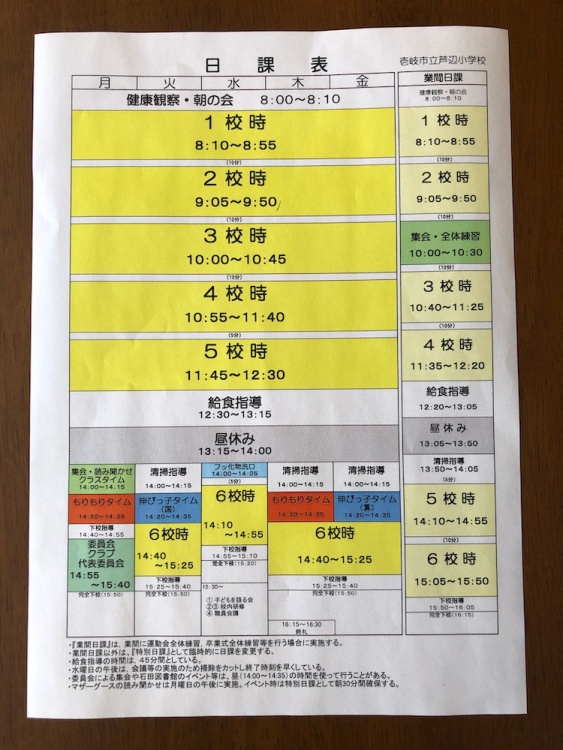
I will go into subjects in a moment, but let’s talk a bit about lunchtime. The biggest difference to Canada is that the school provides food for all students and teachers. Yes, teachers —including the principal — eat with the students. There is much to learn during lunchtime!
Each day is a nutritionally balanced meal prepared by the regional Lunch Center, which supplies all area schools. Each month we get a menu, and the daily variety is amazing! The students don’t get any choice, and are heavily encouraged to finish their whole meal. They usually do since they are starving by 12:30. But learning to be able to eat anything is a great skill, and another way to raise sturdy kids.
At most schools, students will eat in their classrooms, but our school is special since the whole school (44 students) eats lunch together in a big cafeteria-like room. The students all get jobs during lunch time: setting the tables, putting on their lab coats and masks to serve the food, cleaning up, etc. After lunch the students will brush their teeth and then take 45 mins to play outside or go to the library, etc.
After lunch the schedule gets a little more complex. In general there are some short periods meant for practicing reading, reviewing material, or catching up on homework. Then you will have 6th period, the final class of the day which is mostly for the older grades. Younger grades might go home at about 2:30.
However on Tue, Thu, and Fri right after lunch everyone has a very important lesson: cleaning. Students are responsible to keep the school clean and work in little groups on rotation to clean the halls, bathrooms, etc. You have seen Japanese students pushing around scrubbing cloths on the floor right? Under the watchful eye of teachers the students learn the important skill of cleaning.
Subjects
As you can see, a lot of elementary school in Japan is learning life skills (生活指導): the proper way to wash your hands, brush your teeth, handle food, clean, etc. There is a huge emphasis on proper greetings (every student will greet a stranger walking down the street). Respect and responsibility are worthy additions of the traditional 3 R’s of education. For Japanese elementary school students, it isn’t all about academics. Let’s take a look at the subjects covered in each period.
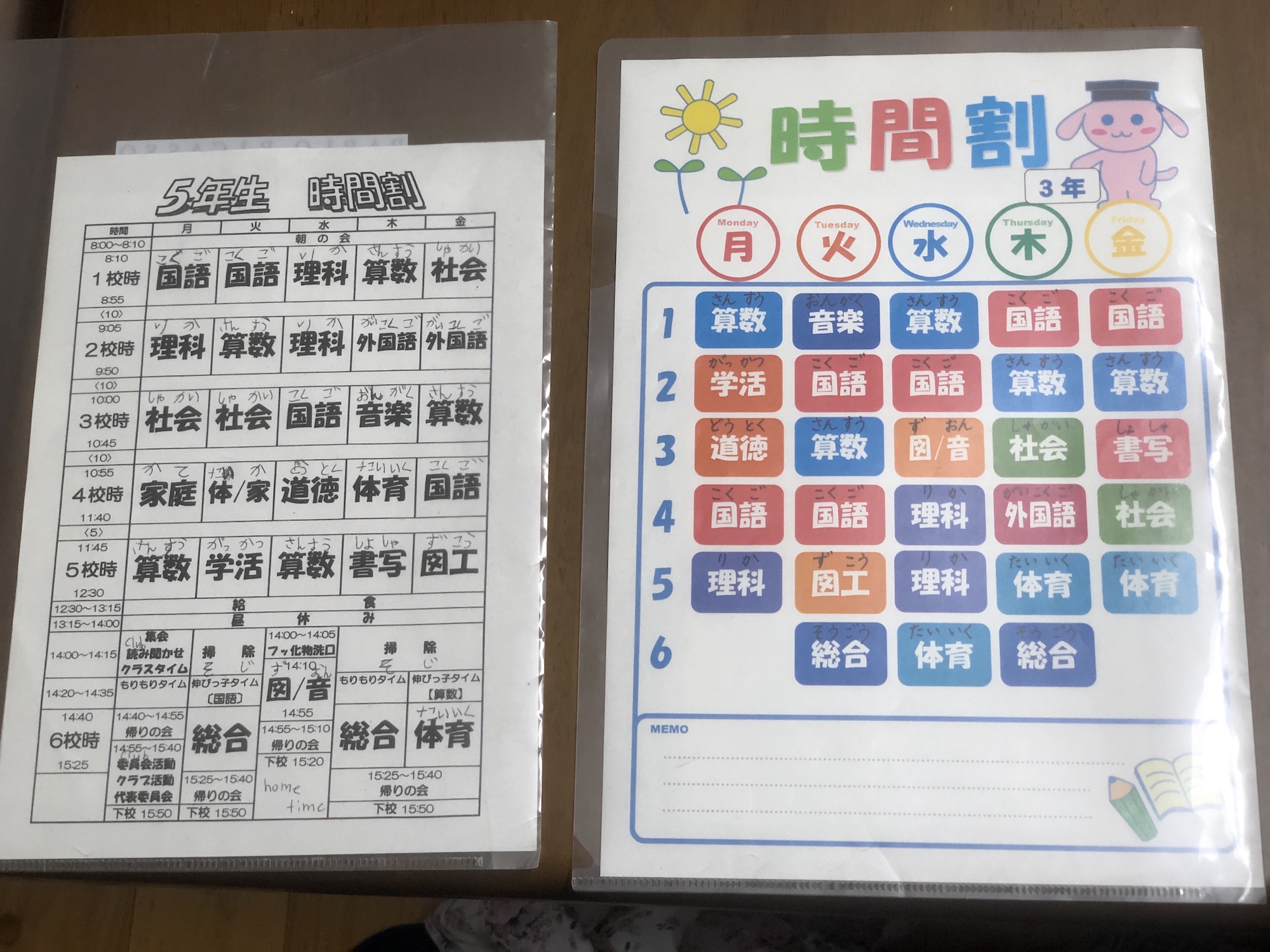
Above are the schedules for my kids’ classrooms. Below is the list of the subjects that both the Grade 3s and the Grade 5s have in common:
- 数学 Math
- 国語 Language Arts
- 理科 Science
- 音楽 Music
- 図工 Arts and Crafts
- 体育 Physical Education
- 社会 Social Studies
- 外国語 Foreign Language (== English)
- 道徳 Ethics
- 書写 Calligraphy (Japanese of course)
- 学活 Activity time
- 総合 Integrated Learning
Most of those should be pretty recognizable. In addition to the above slate of subjects, the Grade 5’s have one more that isn’t taught to the younger students: 家庭 katei or Home Economics.
Other than maybe Ethics and Calligraphy, you might see any of these subjects on the schedule of a Canadian elementary school student. One might stick out: “Integrated Learning.” This is a hands-on period that constantly changes. For example, my Grade 5 daughter has recently been learning about how to assist people with various disabilities (properly guiding a visually impaired person, how to use a wheelchair safely, etc) and my Grade 3 daughter’s class uses this time to take field trips around the village, learning about local history, and visiting local businesses/factories.
There are all kinds of interesting comparisons I could make with regards to how students here actually learn math or music, but I won’t get into that other than to say it is all very lecture-based: a lot of sitting quietly and copying down notes from the board. We were worried that our kids, who have been brought up in a very “active learning” educational environment, would not have the patience to sit for five 45 minute blocks. But they have surprised me!

You may have noticed from the schedule above that after lunch on Monday’s the Grade 5’s don’t have 6th period. This time is for club activities and student committee meetings. The Grade 3s go home early on Mondays, but my Grade 5 daughter stays for Library Club (which is really just putting away the books and maintaining the library). She didn’t want to join the baseball club.
You can see their day is filled full of a mix of academics and life skills. They learn a lot of knowledge, but also the skills to study, to live, and to take care of themselves. From the picture of the front of the school at the top of the post you can see the three key words of our school:
- やさしく Kind
- かしこく Smart
- たくましい Resilient
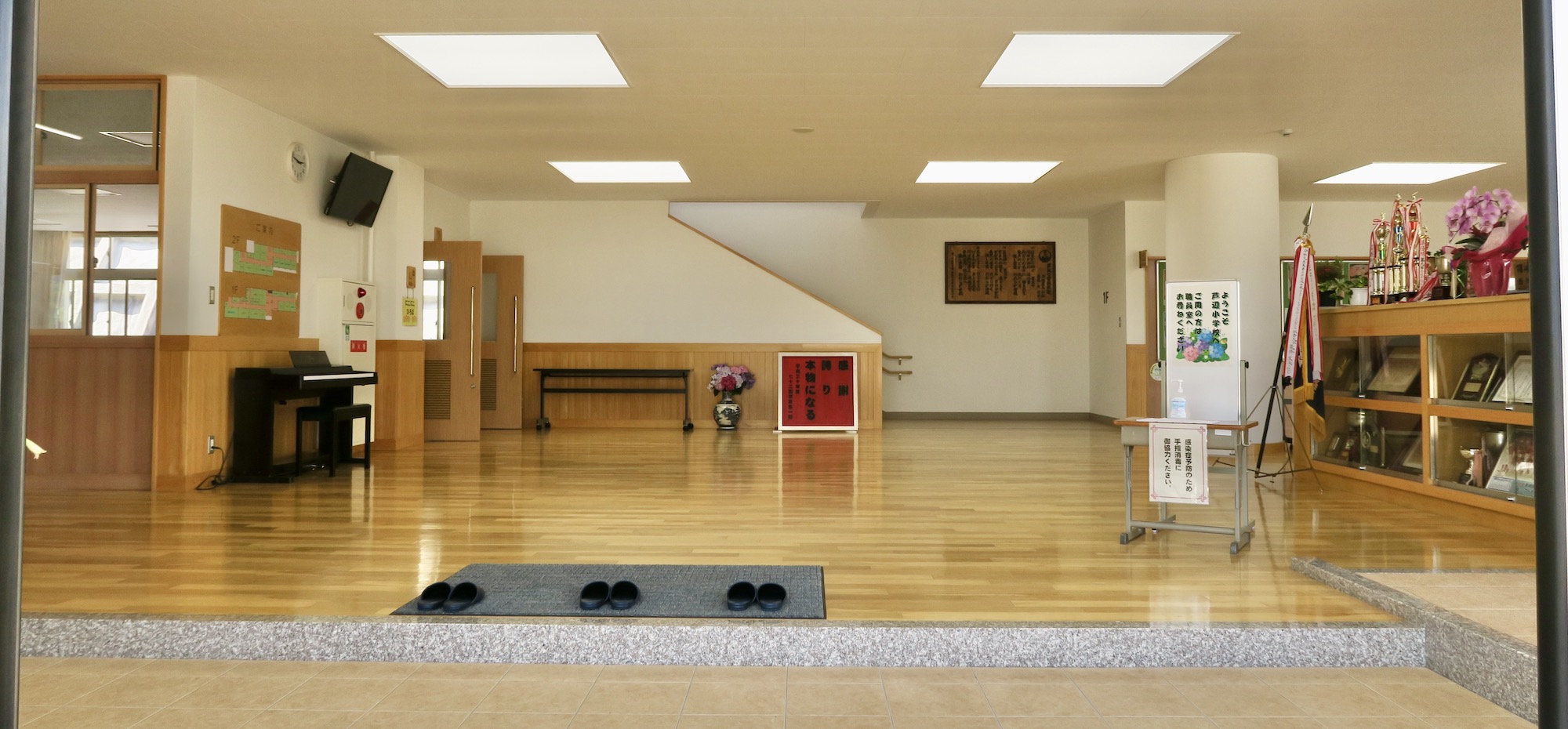
On most days the students are let out of school at 3:50. Our kids usually get home at around 4:15, have a snack, and get started on their homework, sometimes with friends that come over. So far homework has been worksheets for Math and Language Arts, reading and music practice, and some Project-Based Learning projects, all diligently recorded in the homework log which is reviewed and stamped by the teacher the next day.
By evening they are pretty tuckered out. They have a bath, eat a hearty meal, lay out their futons, then prep all their various notebooks, forms, and equipment required for the next day. Some days we might get a 30m show or some Nintendo Switch time in. Before bed time we read a library book (in Japanese) and at about 8:30 it’s lights out. As usual it takes about an hour of sips of water and associated toilet trips before they finally go to sleep. Then the whole cycle starts over again!

Special events: Pool cleaning
Throughout the year there are a number of special events where the school gets the community involved. Which brings me to the matter of more sore, radiating feet.
First up this year was the cleaning of the school pool. All Japanese schools have swimming pools, and learning to swim is one of those practical life skills that every student learns during class time. And like the classroom, it is the students responsibility to maintain and clean the pool.
Most of the pools I have seen at schools are outdoor pools, and so are only used during the summer months. In the fall and winter they are left with a bit of water in them, just sitting there collecting dirt, leaves, frogs, and all kinds of detritus (dunno why they don’t cover them… 🤷♀️). It would be a pretty tough job for the students by themselves, so we have to call in the community… and the local fire brigade!
I arrived at the end of the school day on Monday in flip flops and board shorts. It had been cloudy all day, but I was ready to get wet and dirty. A fire truck pulled up and the fire chief and a few volunteer firefighters/dads unloaded some hoses. A few of the teachers were already in the pool draining it and setting up some pumps, which some other teachers were organizing the students. Once everything was set up, we all lined up around the pool while a class representative (from Grade 6) stepped forward, removed his hat, bowed politely, and gave a welcoming speech to the community, thanking us for our support. We applauded, then the students moved quickly in lines, each grabbing a brush from the stack like a well-trained firefighters heading out to a call, and jumped into the emptied pool.
Teachers, administrators, parents, community members, and students, were all in shorts scrubbing and spraying. The brushes were stiff bristled and long handled, resembling curling brooms. I was able to draw deeply on my maple syrup-powered blood, to lean in on my broom and HURRY HARD like a good Canadian. Represent!

The whole job took about 90 minutes, but it was only about 10 minutes in when all the clouds flew away! Like fearful lambs they scattered across the sky escaping the ravages of an angry sun whose sole purpose was to bake me alive as I stood ankle deep in a swimming pool entirely unprotected by shade or sunscreen. I had made a huge mistake. BUT! I could not let down the students, teachers, and other parents! So I turned on the gaman and turned up the gambaru. For the sake of giving the kids a clean pool to learn the important life skill of swimming, to grow up strong and contribute to society in a productive way, it was the least I could do…
After the last of the muck was pumped out of the pool and everyone got a refreshing rinse with the firehoses, we all lined up at the edge of the pool. The students got into nice orderly lines, and a different student rep gave a little thank you speech, stating his goal to strive to swim the 50 meters this year. We all applauded and the school principal gave his thank you speech, praising the students for a job well done, and for properly working hard and representing the school in front of the community. (The principal had on baggy shorts and was covered in muck, a true role model. This not being his first rodeo, he had a wide brimmed hat that I very much admired).
It was hard work, and the students worked hard. But they also had a lot of fun. The annual pool cleaning is a great team-building activity that the kids will remember forever. In a couple of weeks all the students, parents, and associated groups will be called out again, this time to clean up the local beach. I will be sure to slather myself in sunscreen for that event!


